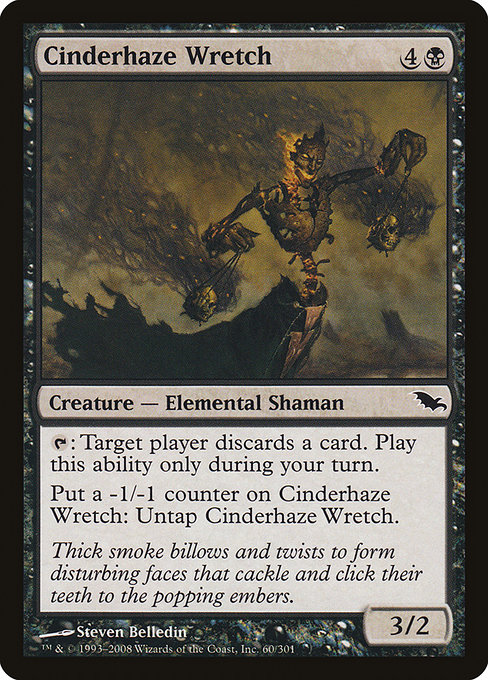
Image courtesy of Scryfall.com
Graveyard Recursion and the Smoke of Shadowmoor
Black has always loved turning hand and graveyard into leverage, and Cinderhaze Wretch is a delightful, budget-friendly captain of that ship. With a mana cost of {4}{B} and a sturdy 3/2 body, it won’t win the race on speed, but it makes up for that with a quiet, persistent engine on your side of the table. The card’s primary ability — “Tap: Target player discards a card. Activate only during your turn.” — is a clean, repeatable way to pressure an opponent while you assemble the late-game pieces that recur from the graveyard. The second ability — “Put a -1/-1 counter on this creature: Untap this creature.” — is the kind of quirky interaction that invites patient planning and careful resource management. Together, these tools create a subtle dance between disruption, board presence, and graveyard value. 🧙🔥
Why this card shines in graveyard-centric lists
Shadowmoor’s smoke-streaked aesthetic mirrors a deck that wants to trade immediate pressure for long-term payoff. The Wretch’s discard trigger can be used in two meaningful ways. First, you can force an opponent to discard a key answer, a spell you fear they’ll draw next turn, or a plan they rely on to stabilize the game. Secondly—and perhaps more thematically, depending on your perspective—you can sacrifice your own cards on purpose, moving them into the graveyard where they become fuel for a finisher or a reanimation payoff later in the game. This dual-use feature is the essence of graveyard recursion: you convert discarded cards into future options. The -1/-1 counter untap mechanic then becomes a pacing tool, nudging you to extend the engine across several turns while your graveyard fills with the seeds of future plays. 🎲
Two workable pathways you’ll likely explore
- Self-discard to stock the graveyard: Use Wretch on your own turn to pitch a critical card you no longer need. That card sits in your graveyard, waiting for the right moment to reappear via a reanimation spell or a fetch-back from the grave. In this lane, you’ll want a compact suite of graveyard payoffs that don’t rely on your entire mana cushion to resolve. The payoff could be a value engine that triggers from having cards in the graveyard, or a reanimation line that resurrects a more threatening creature later in the game. 🧙
- Opponent disruption that synchronizes with recursion: The discard effect is most powerful when it robs the opponent of key tools while you’re already building toward a graveyard-centric capstone. For example, you might disrupt a removal spell or a crucial tactic at a time when you’re ready to flip a card back from the grave—that moment can swing the tempo in your favor and set up your recursion engine for the late game. The synergy is not flashy in a single turn, but it compounds across many turns, which is exactly the kind of design black fans love. ⚔️
Practical deck-building notes
To maximize Cinderhaze Wretch’s potential, think in cycles rather than single-turn wins. A lean black base that can reliably cast the Wretch on curve is ideal, especially if you intend to lean into the graveyard as a resource. You’ll want a few categories within your 60-card shell:
- Graveyard payoffs—these are the cards that reward you for having cards there: recursion, flashback, or mana-efficient reuses of spells from the grave.
- Reanimation or retrieval tools—cards that return creatures from the graveyard to the battlefield to create a board state your opponent must answer. Even if the exact spells aren’t from Shadowmoor-era sets, the concept remains central to a black-focused recursion strategy.
- Counterbalance and resilience—a few ways to protect Wretch from removal or to ensure you can keep pressing while building your graveyard engine.
Flavor and lore align beautifully here. The flame-wreathed art and smoky faces in Belledin’s illustration feel like a gateway into the world where discarded memories drift back into play as something new and dangerous. Shadowmoor was a time when black’s darkness was less about brute force and more about weaving soft, insidious threads—disruption, milling, and the patient accumulation of value. Cinderhaze Wretch captures that spirit in a single card: a compact body with a deceptively rich line of play that rewards a deliberate, multi-turn plan. The card’s common rarity belies its potential to surprise and delight, especially in casual multiplayer tables where players enjoy creative builds that lean into the graveyard as a resource pool. 🎨
“Every discard is a stone laid in the road to the late-game throne.”
If you’re curious about how far a single black creature can bend a game with a well-timed discard and a patient graveyard plan, you’re in good company. The path from a simple tap to force a discard to a full-blown recursion engine is one of Magic’s most satisfying design arcs—especially when you’re the one threading the needle. And as you polish this approach, you’ll find that the quiet, smoky presence of Cinderhaze Wretch is a perfect mentor for the discipline of patient, resilient play. 🧙💎
While you map out your graveyard recursion engine, you can also upgrade your rest between rounds with gear that helps you stay sharp during long nights of games. For a tactile, reliable surface that keeps pace with your precise plays, consider the Custom Gaming Neoprene Mouse Pad 9x7 stitched edges—it's the little edge that helps keep your focus as you count cards and calculate discards. 🎲